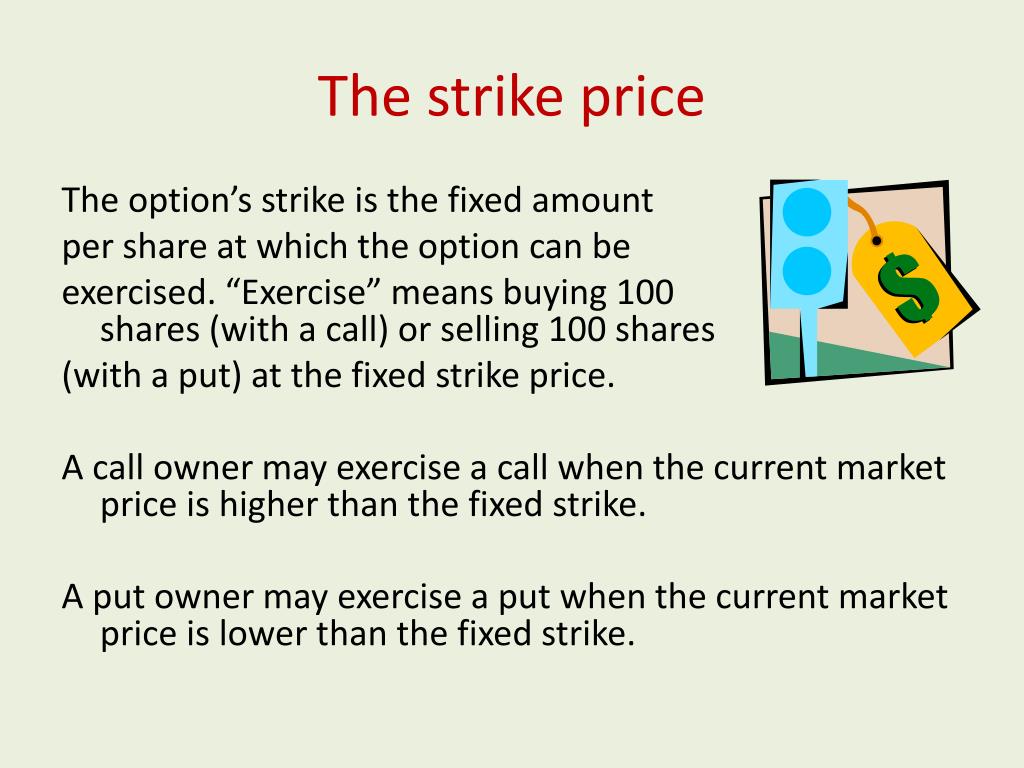Unlocking the Fundamentals of Strike in Options Trading
In the realm of options trading, the concept of strike plays a pivotal role in defining contract specifications and determining potential outcomes. Understanding the intricacies of strike is paramount for savvy traders seeking to harness the power of options effectively.

Image: www.youtube.com
Definition and History
In options trading, strike refers to the specified price at which the underlying asset can be bought (in the case of a call option) or sold (in the case of a put option). Historically, strikes have been predetermined by exchanges based on the prevailing market price of the underlying asset. However, modern electronic trading platforms provide greater flexibility, allowing traders to customize strikes within certain parameters.
Importance of Strike Selection
The strike price directly influences the premium paid for an option contract and the potential profit or loss. A higher strike price typically results in a lower premium but also limits the trader’s potential profit. Conversely, a lower strike price may lead to a higher premium but offers greater upside potential. Choosing an optimal strike price requires a careful assessment of the underlying asset’s price movement and volatility.
Impact on Options Pricing
The strike price plays a crucial role in determining the price of an option contract. If the underlying asset’s price is above (for a call option) or below (for a put option) the strike price, the option is said to be “in-the-money”. In such cases, the option premium typically increases as the difference between the underlying asset’s price and strike price widens.

Image: s3.amazonaws.com
In-Depth Strike Analysis
Traders often analyze historical strike price data to identify patterns and develop trading strategies. By studying the relationship between strike prices, underlying asset prices, and option premiums, traders can gain insights into potential market movements and make informed decisions. Furthermore, tracking option prices across different strike prices provides a comprehensive view of market sentiment and consensus regarding future price movements.
Tips and Expert Advice
-
Thoroughly Research the Underlying Asset: Understanding the price characteristics, volatility, and fundamental factors affecting the underlying asset is essential for selecting an appropriate strike price.
-
Consider Time to Expiration: The time remaining until option expiration also influences strike selection. Traders should assess the potential for significant price movement within that time frame to choose an optimal strike price.
-
Follow Market Trends and News: Staying abreast of real-time market movements, news events, and expert commentary helps traders make informed decisions about strike prices. Monitoring social media and trading forums can provide valuable insights.
Explaining Tips in Detail
-
Thorough Research: Due diligence on the underlying asset’s historical price data, financial statements, industry trends, and geopolitical events can equip traders with a comprehensive understanding of its price dynamics.
-
Time to Expiration: Carefully considering the option contract’s expiration date is crucial. Options closer to expiration have lower time value and may be more sensitive to sudden price changes in the underlying asset.
-
Market Monitoring: By continuously monitoring market movements, traders can identify potential shifts in supply and demand, which can impact option prices and strike selection strategies.
FAQs
Q: What is the difference between a “strike price” and an “exercise price”?
A: Strike price is the specified price at which an option contract can be exercised, while exercise price refers to the actual price at which the underlying asset is acquired or sold upon exercise.
Q: Can I trade options at any strike price?
A: While exchanges typically determine a range of strike prices for each underlying asset, electronic trading platforms may offer more flexibility, allowing traders to customize strikes within certain limits.
Q: How does volatility affect strike selection?
A: Higher volatility in the underlying asset can lead to wider premiums and greater price fluctuations. Traders should consider the potential for significant price movements when choosing a strike price in volatile markets.
Strike In Options Trading

Image: www.slideserve.com
Conclusion
In options trading, understanding strike is crucial for unlocking the full potential of contracts. By carefully selecting the strike price, traders can define their risk and potential profit parameters, while also taking into account market dynamics and expert insights. Whether you’re a seasoned trader or just getting started, mastering the art of strike selection empowers you to navigate the options market with greater confidence and precision.
Are you ready to explore the exciting world of options trading with a deeper understanding of strike? Engage with us to learn more!






